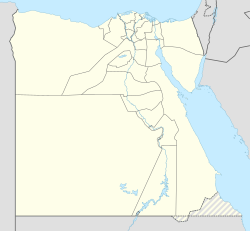History
The station was built in tunnels, formed by the ancient Egyptians to quarry out limestone for the casing stones of the pyramids.
Tura Quarries
According to recent surveys, the quarrying system involved interconnecting tunnels, known as “fingers”. These tunnels were arranged roughly parallel to each other, conforming to the shape of a human hand. Each tunnel was managed by a foreman responsible for the excavation. Well-reposed natural pillars and dry-packed stone walls with rubble cores to support the roof were used to prevent collapse. Despite the safety precautions, mining accidents were frequent due to negligence in the maintenance of the support structures. Rubble from excavations were also repurposed to reinforce tunnels. Tools like heavy wooden mallets, steel edges, and brass bolsters were used to split stone blocks. [1] [2]
RAF Tura
In 1941, RAF Tura was originally built as a military storage installation used by the British Army. In September 1941, the No. 2 Field Survey Depot RE with other units moved into the station, as RAF Heliopolis was considered too vulnerable. The No. 19 Field Survey Company RE was also stationed the following month, with printing and drawing sections established in the caves. [2]
Located in the general engineer sections included stripping, cylinder machining and engine assembly. The station also operated engine test benches, which the sound was muffled over the dunes, and engine repairs were also in constant demand. [3] On 22 August 1942, Winston Churchill inspected No. 111 Maintenance Unit and recorded that "Everything looked very smart and efficient on the spot, and an immense amount of work was being done day and night by masses of skilled men. But I had my tables of facts and figures and remained dissatisfied. The scale was far too small." [4] The No. 111 Maintenance Unit was formed from a sub-station of the 109 MU in August 1941, and by October 1942, had moved into RAF Tura to repair aircraft engines of the Royal Air Force. No. 111 MU established aircraft and engine repair, signals repair, general engineer sections within the caves, which also housed Army elements and a small hospital. In November 1942, a boxing ring was constructed and held tournaments by RAF personnel. [5] [6]
1943 - 1947
In August 1943, the Depot War Establishment was amended, with the unit mostly consisting of Palestinian and Jewish personnel, which released UK survey tradesmen to pursue more important work. Following the cease of hostilities in 1947, the station was evidently closed, and by March, No. 111 Maintenance Unit was disbanded. In February 1947, the remaining survey units in RAF Tura moved out to the Survey Camp at Abbassia, Cairo. [2] By April 1947, following the decision to consolidate UK units to the Canal Zone, the units were moved to RAF Fayid. [7]
This page is based on this
Wikipedia article Text is available under the
CC BY-SA 4.0 license; additional terms may apply.
Images, videos and audio are available under their respective licenses.
